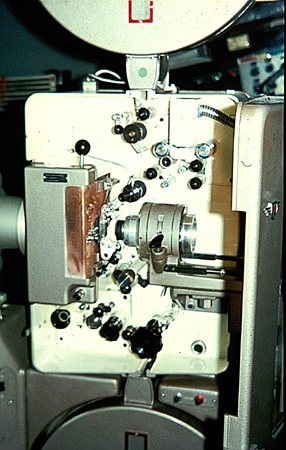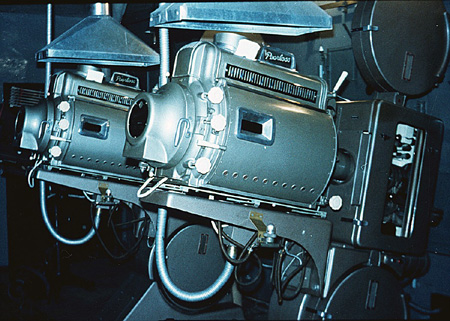Philips DP70 at the ABC Coleshill Street, Birmingham, England |
Read more
at in70mm.com The 70mm Newsletter |
| Written by: John Duddy, Chief projectionist (retired) | Date: 17 July 2005 |
 This
is the box crew at the ABC GAIETY CINEMA Coleshill Street (as it was known
as then in 1967) This
is the box crew at the ABC GAIETY CINEMA Coleshill Street (as it was known
as then in 1967)Left to right, Alan Morgan Fourth, Stelious Theopandies Second, John Duddy Chief, and Graham Lee Third. The picture was taken by the ABC company to celebrate the winning of The Midlands Best Kept Box Competition. Sitting at home retired as an old man of 76, I recall way back in the 1960's when the Philips DP70 mm projectors were first installed at the ABC Coleshill Street Birmingham. The job of installing the machines involved much extra work for the projectionist team, for starters, the massive projector heads had to be carried from the ground floor switch room, right up to the box, level with the theatre roof. Two of the four projectionists carrying them up the steep narrow winding stairs were mere teenage boys. I had to warn them not to hesitate to say DOWN when they wanted a break. Fortunately the solid and even heavier bases for the machines came up over the box roof via a giant crane parked outside the front door, as did the Arc rectifiers, which could run at over 140 amps. The Lamps themselves were Mole Richardson, and required to be graphite lubricated every day without fail. One cinema which failed to do so, ground to a halt in the middle of the film. The arc lamps were water cooled, with uncoated positive, and copper coated negative. These arcs I found to be very reliable, provided you did the maintenance, and were indeed just like the Philips DP 70 projectors. The Philips six channel valve sound amplfiers with an output of 25watts each channel, gave a very sweet and musical sound, unlike the transistor amplifiers of that period. |
Further
in 70mm reading: DP70s in England Internet link: |
 The first presentation was Warner's "CHEYENNE AUTUMN", which was John Fords
last western. This was the complete version, as I understand that certain
scenes were later cut out for ordinary release. Filmed in Super Panavision,
projected at 130 amps on to a 43 foot screen, it looked stunning. However
I was equally impressed by the six channel stereo sound produced by the
Warner Bros studio sound department, which was crystal clear. I felt at
the time that this was a "try out" by Warner's to see if the theatre and
it's staff were equal in presentation to the calibre of the 70mm films
coming along. It was a proud moment when we started running the "teaser
trailers" followed by the trailer for the Midlands premiere of "My Fair Lady". The first presentation was Warner's "CHEYENNE AUTUMN", which was John Fords
last western. This was the complete version, as I understand that certain
scenes were later cut out for ordinary release. Filmed in Super Panavision,
projected at 130 amps on to a 43 foot screen, it looked stunning. However
I was equally impressed by the six channel stereo sound produced by the
Warner Bros studio sound department, which was crystal clear. I felt at
the time that this was a "try out" by Warner's to see if the theatre and
it's staff were equal in presentation to the calibre of the 70mm films
coming along. It was a proud moment when we started running the "teaser
trailers" followed by the trailer for the Midlands premiere of "My Fair Lady".I made special arrangements for this Midlands Premiere engagement, All the five colours were removed from the front of circle mounted colour wheel spotlights, and replaced with pink. So you could have any colour you wanted as long as it was Pink. Since the on film overture also showed pictures of flowers, I made arrangements for, at the start of each performance, for one of the juniors to go to the Plenum chamber room at the rear of the cinema, and spray in Cromessol floral disinfectant, usually Spring Flowers or Rose. So whether it was considered by the public as part of the film or not, I will never know, as when the "My Fair Lady" Overture started, and the flowers appeared on screen, the air inside the ABC Coleshill Street was perfumed with the floral essence. After all this effort, not a word was ever said by either management, staff or patrons at the "smellovision" presentation. We somehow felt that Jack Warner would appreciate the effort. |
|
 This
is Graham Lee as he worked with me at the ABC Coleshill Street in the late
60's early 70's. posing with Dudley Moore´s Lea Francis Special Rally car
from the film "Monte Carlo or Bust" also starring Peter Cooke. This
is Graham Lee as he worked with me at the ABC Coleshill Street in the late
60's early 70's. posing with Dudley Moore´s Lea Francis Special Rally car
from the film "Monte Carlo or Bust" also starring Peter Cooke.Click Image to see Mr. Lee working with IMAX We were advised that due to the importance of this film that the normal Film Transport Service would not be employed in the delivery of the copy of this film, which came direct by air from Warner Bros Studio, Warner Boulevard, California. Imagine my surprise when I arrived one morning to find that the "special" delivery had arrived early am, and I was advised by one of the cleaning ladies that "Chief, there's a lot of tin boxes lying outside the switch room door on the pavement in Coleshill Street" Sure enough all the reels in separate tin boxes had been abandoned in the street sometime prior to the cleaners arrival at 8am, and remained there until my arrival at 10am. The print came supplied with an extra set of film leaders, which of course we never used. |
|
 ABC
Coleshill St DP 70's with later Peerless Magnarcs fitted, and note these
were suitable for 70mm projection without the complications and cost of the
Mole Rishardson arc. ABC
Coleshill St DP 70's with later Peerless Magnarcs fitted, and note these
were suitable for 70mm projection without the complications and cost of the
Mole Rishardson arc.Gaiety box 1966 approx. (I find I should clarify the situation concerning the use of the PEERLESS Magnarcs. Please note that while these proved good on test, and were used with the DP 70's for 35mm film. These PEERLESS ARC were NEVER used for the public display of any 70mm feature films played at ABC Coleshill St Birmingham. So what the picture is in fact showing, is the Philips DP 70 projector set up for the running of 35mm film. With these MAGNARCS installed (a 20 minute job) it was possible to run 35 mm as easily and cheaply as a conventional 35mm installation - John Duddy.) About this time the Cinerama operation was dying for the lack of product, and the giant cinerama screens were not suitable for the normal 35mm release films. ABC arranged after about 4 weeks run for several reels of Coleshill Streets copy of "My Fair Lady" to be taken by the District Engineer Mr Everard New for trial at the nearby ABC Bristol Road Cinerama Theatre. Mr Nick Mole the ABC circuit chief engineer drove up from London for the occasion. He first watched the Ascot Gavotte number at Coleshill Street, ( I was running the arc lamps at 145amps, When the scene started, he turned to the district engineer and said " Go upstairs and see what he is running at" He later asked me about this and I was able to give him a satisfactory explanation which he accepted, mainly that it prevented carbon waste, the only extra cost to ABC being in the power used. The test at ABC Bristol Road Cinerama was judged as satisfactory, and the film, much to the confusion of the public, (and regret on my part) was transferred for screening on the giant 78 foot wide Cinerama screen. I later watched part of this and it was NOT a pretty sight, as the characters depending on screen position, became either thin or fat, depending on the screen position. While the previous edge to edge even coverage of light at Coleshill Street, became a bright spot in the middle of the giant screen. |
|
 Without a doubt the highlight of my career as a projectionist, including
later work in television, was the running in 70mm of "My Fair Lady". One day
between performances I spoke to the projection staff and told them that
what they were seeing was a unique situation for cinema, and that it would
soon be gone. Regrettably, and mores the pity I was correct, though the
events which took place some 45 years ago still haunt my mind, and remain
to this day the highlight of my working life. Without a doubt the highlight of my career as a projectionist, including
later work in television, was the running in 70mm of "My Fair Lady". One day
between performances I spoke to the projection staff and told them that
what they were seeing was a unique situation for cinema, and that it would
soon be gone. Regrettably, and mores the pity I was correct, though the
events which took place some 45 years ago still haunt my mind, and remain
to this day the highlight of my working life. |
|
|
Go: back
- top -
back issues
- news index Updated 22-01-25 |
|
